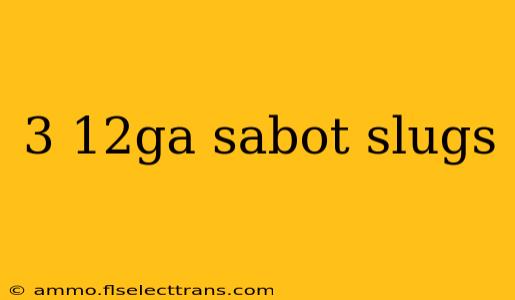3 12 Gauge Sabot Slugs: A Deep Dive into Performance, Applications, and Safety
The 12 gauge shotgun, a venerable firearm with a rich history, offers remarkable versatility. From birdshot for small game to buckshot for home defense, its adaptability is legendary. But for longer-range accuracy and increased stopping power, many shooters turn to sabot slugs. This article will delve into the specifics of using three 12-gauge sabot slugs, exploring their performance characteristics, practical applications, and crucial safety considerations.
Understanding Sabot Slugs
Unlike traditional rifled slugs, which engage the barrel's rifling directly, sabot slugs utilize a plastic or polymer sabot (a kind of sleeve). This sabot houses the slug, allowing it to easily travel down the smoothbore barrel of a shotgun. Once the sabot exits the muzzle, it separates from the slug, leaving the projectile to continue on its trajectory. This design allows for increased accuracy and velocity compared to standard rifled slugs, especially at longer ranges. The use of three slugs in a single shot, however, is a unique scenario deserving of closer examination.
The Three-Slug Scenario: Advantages and Disadvantages
Firing three 12-gauge sabot slugs simultaneously, often achieved through a modified shotgun or the use of multiple shells, presents a complex scenario with both potential advantages and significant drawbacks.
Potential Advantages:
- Increased Hit Probability: The idea behind deploying three slugs is to increase the likelihood of hitting a target, especially at longer ranges where single-slug accuracy might be compromised.
- Greater Stopping Power: Three slugs impacting a target deliver substantially more energy than a single slug, potentially leading to increased stopping power.
Significant Disadvantages:
- Pattern Dispersion: Even with a tightly grouped shot, three slugs will still have a wider spread than a single slug. Accuracy suffers at extended ranges.
- Recoil: The recoil from firing three slugs simultaneously will be dramatically increased, making the shot uncomfortable and potentially unsafe for some shooters. This increased recoil can also impact accuracy.
- Legal and Ethical Considerations: Depending on your location and the intended use, firing three slugs may violate hunting regulations or ethical hunting practices. Always check local laws and regulations.
- Barrel Stress: Firing three slugs puts significant stress on the shotgun barrel. Repeated use can lead to barrel damage or failure.
Applications of Three Sabot Slugs (If Applicable)
While the use of three sabot slugs in a single shot is not common, niche applications might exist. These include:
- Large Predator Control (with extreme caution): In situations requiring extreme stopping power, and where safety and legality are strictly adhered to, three slugs might be considered for large predator control. This is a highly specialized scenario and should only be undertaken by experienced professionals.
It is crucial to emphasize that this is not a standard or recommended practice. The disadvantages significantly outweigh the benefits in most situations.
Safety Precautions: paramount importance
- Always check local laws and regulations: Ensure your use of three slugs complies with all applicable hunting and firearm laws.
- Professional Guidance: If considering such a setup, consult with an experienced firearms professional or ballistics expert to assess the risks and feasibility.
- Proper Training: Sufficient training is essential to safely and effectively handle a shotgun capable of firing multiple slugs.
- Appropriate Gear: Eye and ear protection are mandatory. Consider wearing a recoil pad to mitigate the increased recoil.
- Barrel Inspection: Regularly inspect your shotgun barrel for damage. Any signs of wear or stress should be addressed immediately by a qualified gunsmith.
Conclusion
While the concept of firing three 12-gauge sabot slugs simultaneously might seem appealing for increased stopping power, the practical disadvantages—including increased recoil, pattern dispersion, legal ramifications, and barrel stress—strongly outweigh any perceived benefits. Single sabot slugs offer excellent performance within their design parameters. Focusing on proper shot placement and marksmanship is far more effective than attempting to compensate for lack of skill with a modified, potentially unsafe, firing system. Always prioritize safety and adhere to all relevant laws and regulations.

